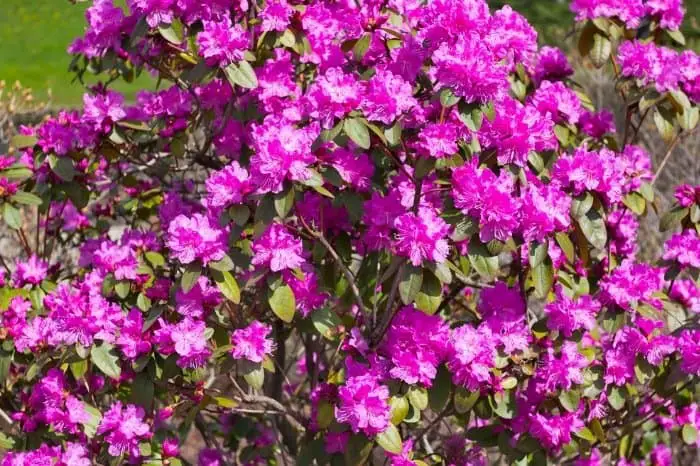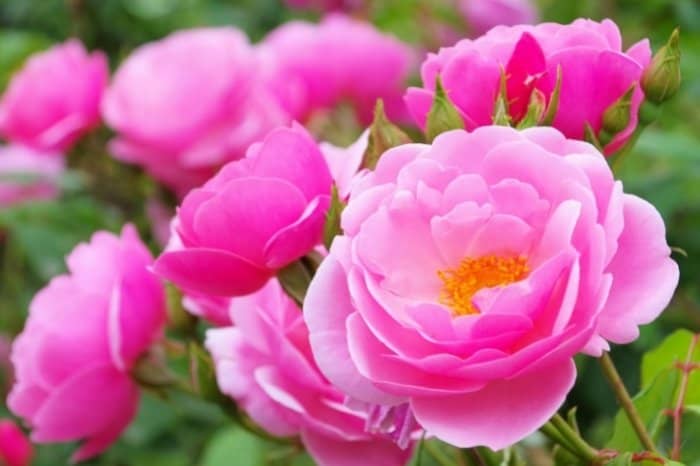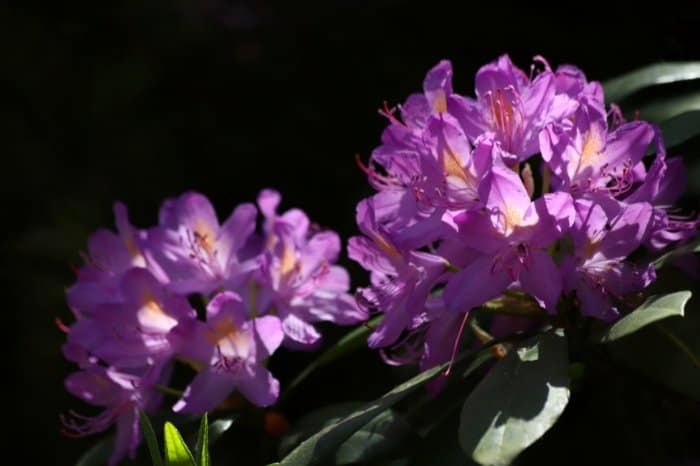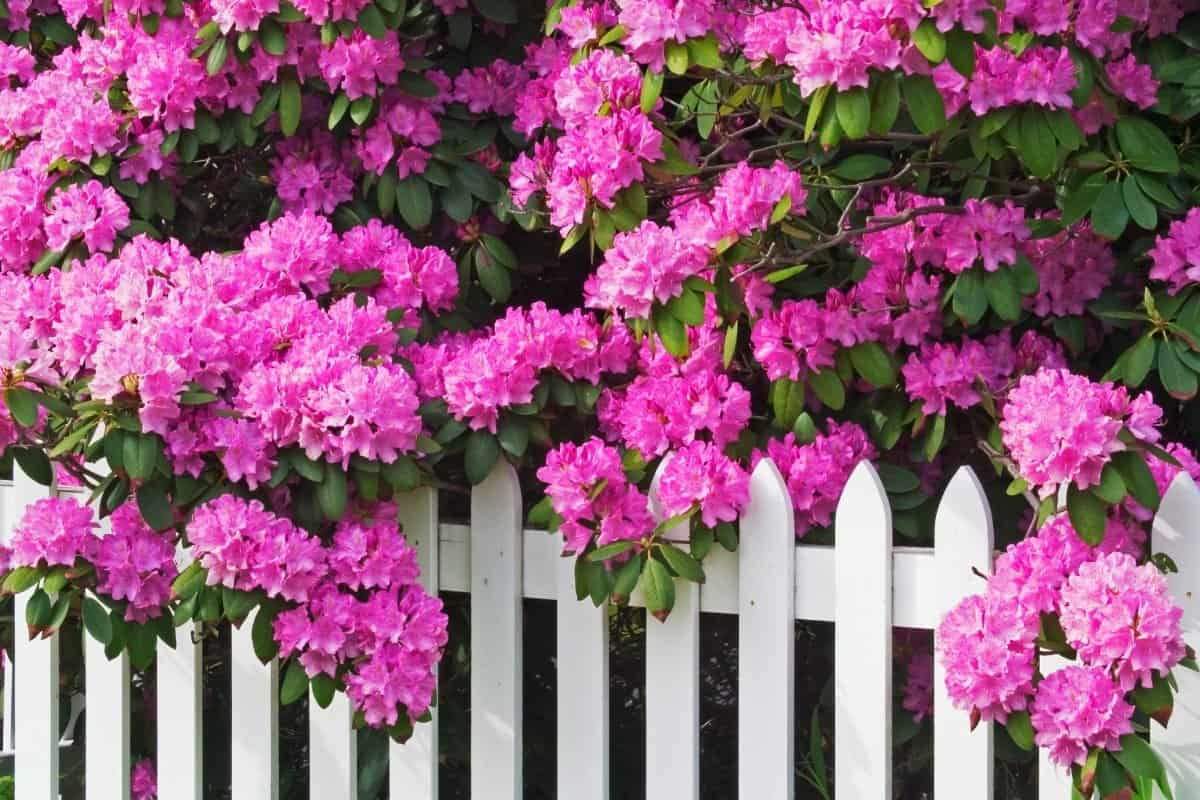Last Updated on February 11, 2022 by
Rhododendron comes from two Greek words—”rhodon,” meaning rose, and “dendron,” meaning tree; but what does a rhododendron look like?
Despite the name deriving from Greek, rhododendrons grow all over America and other countries as shrubs.
Rhododendron shrubs are evergreen or deciduous, with some growing as wild, but most are cultivated. These flowers are popular with most gardeners and landscapers due to their large and attractive flowers.
The flowers this plant produces are beautiful, with showy blossoms and a gorgeous display of colour. Late April, May and June is a wonderful time of the year for these flowers to bloom.
Let’s learn everything about this flower, so you grow it with a better understanding.
So What Does A Rhododendron Look Like?
Cultivated rhododendron are evergreen plants with large leaves and remarkable flowers that bloom in late spring. Most of these flowers bloom from April to June, and sometimes the flowers last until late summer.
Ornamental rhododendrons have large, oval leaves with a medium or glossy dark green upper surface and a pale, dull green lower surface. Their flowers are bell-shaped and come in clusters known as trusses, and they vary in colour – white, pink. Orange, yellow, red, and purple. Their flowers have spots of a different colour from the rest of the flowers.

It is believed that about 1000 species of rhododendrons exist belonging to the family Ericaceae. All rhododendron plants belong to the genus Rhododendron. There are many varieties of plants in the Rhododendron genus, and the different varieties hybridize easily, making it tough to classify them.
Does Rhododendron Look Like Azaleas?
It may seem strange to many who do not know that Azaleas are a type of rhododendron. The genus Rhododendron has 8 subgroups, and Azaleas belong to 2 of these subgroups.
Azaleas are attractive flowering shrubs grown for their flowers. Their flowers are not as large and showy as those of the rhododendrons, but they are as popular. Azaleas are deciduous that have smaller leaves and are shorter in height. They have funnel-shaped flowers than rhododendron ones with 5 stamens.
Point to note: All azaleas are rhododendrons, however not all rhododendrons are azaleas. The evergreen azaleas belong to the subgenus Tsutsui, while deciduous azaleas are classified in the subgenus Pentanthera.
The Differences Between Azaleas And Rhododendron
Most people tend to confuse between these two plants – Rhododendrons and Azaleas. Here are some differences to remember
Azaleas are deciduous, which means they will lose their leaves in the fall while Rhododendrons are evergreen – they keep their leaves during winter with the exceptions of R. mucronulatum and R. dauricum.
They have appressed hairs, which is hair parallel to the leaf’s surface, while Rhododendrons are scaly or have dots adorning the underneath of their leaves.
Azaleas produce tubular or funnel-shaped flowers, while rhododendrons flowers are more bell-shaped.
They come with 5 stamens per lobe and 5 lobes in the flower, while rhododendrons have more than 10 stamens or 2 per lobe.
Wild Rhododendron Species
Besides the cultivated species, there are wild species of this flower that grows beautifully too. They include:
Rhododendron macrophyllum is found in the Pacific Northwest region of North America. It derives its names from the pacific, Western and Coast Rhododendron. This plant has pink flowers and is used as the state flower of Washington.
Rhododendron arboreum is used as the national flower of Nepal. It’s popularly known as gurans or laligurans in that country and grows to form magnificent mountain forests. It produces bright red flowers that change to pink or white as the elevation increases. This wild rhododendron is also found in Bhutan, India, Myanmar, China and Sri Lanka.
Miracle-Gro Shake ‘N Feed Flowering Trees and Shrubs Continuous Release Plant Food
Types Of Rhododendron
Rhododendron ‘Elviira’
These are hardy and shade-loving rhododendrons. They prefer cooler regions as far as zone 4. They have bright red, showy flowers that make a great choice for a short hedge. Adding Epsom salts to the soil brightens the dull leaves back to their natural shiny hue.
Rhododendron ‘Blue Peter’
This variety is sun-tolerant with elegant, frilly lavender flowers. Their bloom appears in mid-spring, and their shrubs grow to a height of about 4 feet tall. This variety prefers slightly acidic soils and good drainage.
Rhododendron ‘Boule de Neige’
Also known as the ball of Snow in English, this variety prefers deep-shade. It produces big balls of white flowers in spring. This variety easily dies from waterlogging.
Rhododendron ‘Bow Bells’
This variety has pink, bell-shaped blooms and rounded foliage that makes it a favourite among many gardeners. The foliage has a bronze colour when young but turns to deep green when it matures.

Rhododendron ‘Windsong’
This type has evergreen foliage with unusual lush yellow blooms that combine with its glossy green leaves. This variety loves shade and takes no more than 4 hours of direct sunlight per day. You can plant it under trees as long as the trees do not have surface roots.
Rhododendron ‘White Angel’
This variety produces semi-evergreen blooms in plenty starting from mid-April. It can grow up to 6 feet tall with long-lasting, showy white flowers that thrive in deep or partial shade. After blooming, it’s important to prune it back to keep it looking vibrant.
Rhododendron ‘Nova Zembla’
It reaches up to 8 feet producing a cluster of crimson blooms. It thrives in shady areas, and you can try it as a hedge too.
Rhododendron ‘Black Satin’
This type has deep pink flowers blooming early spring to give way to dark purple-black foliage come winter. This flower type brings dynamic interest to your garden. It thrives against slopes and buildings but does not like west and south winds.

FAQs
What is the difference between a rhododendron and an azalea?
Rhododendron is a genus of about 700 species of flowering plants native to temperate regions of the Northern Hemisphere, Asia, and Australia. The flowers are typically in large, showy clusters. Azaleas are native to temperate regions of the Northern Hemisphere, from Canada to northern China, and are classified into three groups based on leaf shape.
Rhododendrons and azaleas are popular garden plants worldwide. The Rhododendron Society of America (RSO) is an international society for the promotion of the horticultural use of rhododendrons and azaleas. The rhododendron has been used in traditional Chinese medicine. Etymology The word rhododendron comes from two Greek words:
rho, meaning "rose", and dendra, meaning "tree". The leaves are deciduous and the plant bears flowers that bloom in early spring. The genus was named by Carl Linnaeus in 1753 as a combination of the Greek words rho, meaning "rose", and dendron, meaning "tree". Rhododendrons are among the most popular plants for gardens worldwide, and they are used in parks and conservatories. They are also grown as street trees. Rhododendrons were once thought to be hardy only in the north temperate regions, but now can be found growing successfully in subtropical climates as well.
How do I make my rhododendron thicker?
There are a number of factors involved, but in general the biggest thing is the soil.
The plants need good drainage and good nutrients. They also need plenty of light. When you water the plants, make sure it's not too wet or too dry. It should be just right. The best time to water is just before a rain storm. And finally, the plants need enough room to grow.
Do rhododendrons grow well in the shade?
If you have a good base of organic matter, then your soil should be able to hold more moisture and nutrients for your plants to use. The other factor is light intensity. Rhododendrons are a group of plants that have evolved to be most productive in low light conditions.
If you’re growing them in full sun, they may not be able to take advantage of their natural habitat. Soil that receives regular watering and fertilization will also be better suited to rhododendrons.
What month do you prune rhododendrons?
Late November through early December. Rhododendron are very long-lived, but they don't really grow like a tree. They start out with a very large root system, which is then divided into a number of smaller roots, each of which grows until it is about 2 feet high, at which point it stops growing and sends out new roots.
These roots spread out in all directions, but they mostly remain in the same general area, although some of them may branch off. Rhododendrons and azaleas are most easily propagated by dividing plants. This process is called layering. A rhody plant can be divided in mid-summer, when the leaves die back and new leaves emerge.
Layering is a simple process. Take a cutting with a sharp knife. Make it about 2 inches long, and use a little rooting hormone on it. Lay the cutting on its side in the soil, and cover with soil. Keep it moist, but not wet. Place the rhody in a bright place, where there is no shade. The cut will root and grow roots within a few days.
Conclusion
FAQs
What is the difference between a rhododendron and an azalea?
Rhododendron is a genus of about 700 species of flowering plants native to temperate regions of the Northern Hemisphere, Asia, and Australia. The flowers are typically in large, showy clusters. Azaleas are native to temperate regions of the Northern Hemisphere, from Canada to northern China, and are classified into three groups based on leaf shape.
Rhododendrons and azaleas are popular garden plants worldwide. The Rhododendron Society of America (RSO) is an international society for the promotion of the horticultural use of rhododendrons and azaleas. The rhododendron has been used in traditional Chinese medicine. Etymology The word rhododendron comes from two Greek words:
rho, meaning "rose", and dendra, meaning "tree". The leaves are deciduous and the plant bears flowers that bloom in early spring. The genus was named by Carl Linnaeus in 1753 as a combination of the Greek words rho, meaning "rose", and dendron, meaning "tree". Rhododendrons are among the most popular plants for gardens worldwide, and they are used in parks and conservatories. They are also grown as street trees. Rhododendrons were once thought to be hardy only in the north temperate regions, but now can be found growing successfully in subtropical climates as well.
How do I make my rhododendron thicker?
There are a number of factors involved, but in general the biggest thing is the soil.
The plants need good drainage and good nutrients. They also need plenty of light. When you water the plants, make sure it's not too wet or too dry. It should be just right. The best time to water is just before a rain storm. And finally, the plants need enough room to grow.
Do rhododendrons grow well in the shade?
If you have a good base of organic matter, then your soil should be able to hold more moisture and nutrients for your plants to use. The other factor is light intensity. Rhododendrons are a group of plants that have evolved to be most productive in low light conditions.
If you’re growing them in full sun, they may not be able to take advantage of their natural habitat. Soil that receives regular watering and fertilization will also be better suited to rhododendrons.
What month do you prune rhododendrons?
Late November through early December. Rhododendron are very long-lived, but they don't really grow like a tree. They start out with a very large root system, which is then divided into a number of smaller roots, each of which grows until it is about 2 feet high, at which point it stops growing and sends out new roots.
These roots spread out in all directions, but they mostly remain in the same general area, although some of them may branch off. Rhododendrons and azaleas are most easily propagated by dividing plants. This process is called layering. A rhody plant can be divided in mid-summer, when the leaves die back and new leaves emerge.
Layering is a simple process. Take a cutting with a sharp knife. Make it about 2 inches long, and use a little rooting hormone on it. Lay the cutting on its side in the soil, and cover with soil. Keep it moist, but not wet. Place the rhody in a bright place, where there is no shade. The cut will root and grow roots within a few days.
Growing healthy and long-blooming rhododendrons require properly amended soils and the right location to ensure they bloom to their maximum.
Rhododendron care is minimal, which encourages many gardeners to grow these beauties. The care includes adequate watering, pruning, and deadheading the flowers to encourage abundant blooming.
Now that we know what rhododendron look like, it’s time to grow them in gardens or as hedges in our homes.
Flower hedges are the best to have if you are a flowery person. The bloom will bring more bees and butterflies around, and what a better way to spend summer than picking beautiful flowers from your garden.
Caroline is a gardener who loves to get down to the nitty–gritty of gardening. She proudly proclaims herself as a ‘dirt worshipper‘ and can often be found deep in the garden, covered in soil and singing to her plants. As a self–proclaimed ‘plant whisperer‘, Caroline believes that plants need love and attention just like any other living thing, and she loves to give them both. When she‘s not tending to her garden, you can often find her researching the latest gardening trends, or teaching others how to make their gardens thrive



